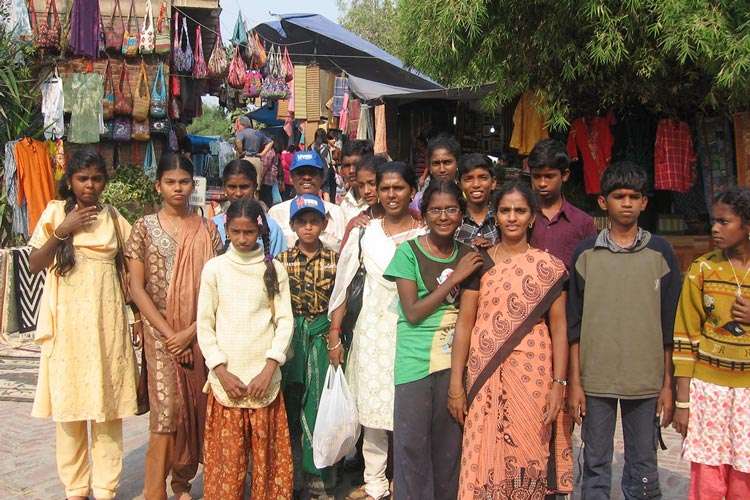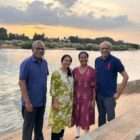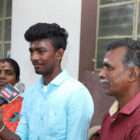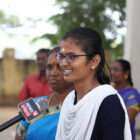Thirteen children and three adults went on a one-week tour of Delhi, in November 2011, sponsored by YOKE. Some of their travelogues were featured (translated from the original Tamil) in Terrascape, a travel magazine. The articles that were published are reproduced here:
A First Step Forward
A Uchimahali (Store in-charge, Sun Paper Mills Co-operative Stores, Cheranmahadevi)
Off the bus track, one-and-a-half kilometres through the green-pas-tured lap of Mother Earth, surrounded by the Tamraparni River and lush green paddy fields, is our beautiful village Kodaganallur, which boasts of a 1,000-year history. The ancient temples and the river are our proud heritage. Our children walk a mile to school. At best, they have gone up to 14 kms to Tirunelveli, the nearest ‘city’. They had till now found joy in spotting a train trudging across the bridge over the river. None of them, or I, ever dreamt of travelling 2,845 kilometers one day.
That day dawned on November 5,2011. The entire village gathered to send us off and wish us well. As we boarded the train, I saw 14 lotuses bloom that evening – I am referring to the happy faces of our children! The two days’ journey went off with us singing, playing games, enjoying the vast rivers, going over strong bridges and through tunnels cutting across the mountains. We wanted to share our joy and made friends with strangers travelling with us. As we reached Nizamuddin station in Delhi, a bunch of roses – once again I am referring to young children – welcomed us so warmly.
The next day we went to Bal Bhavan. The Surya Gallery showed us how well we can utilise the energy of the sun. In the gallery there was a plaque with ‘sun’ written in various languages. We wrote suriyan in Tamil with chalk on this plaque and were overjoyed. Then we went to Shankar’s Dolls Museum and from the wonderful collection there appreciated the culture and beauty of different nations.
The following day we went to the Parliament House where we could enter after a lot of security checks. We were told that the building was constructed by the British. We were very happy to actually stand in the lok sabha and rajya sabha chambers and the Central Hall. We were very happy to actually stand at places we had only seen on TV. We then went to the Parliament Museum. We were moved as went on the Dandi March with Mahatma Gandhi. We also heard Pandit Nehru’s famous speech in his own voice. I was in bliss, sitting with a lifesize statue of Sardar Vallabhai Patel, as I heard the speech.
The next day we went on a hop-on-hop-off tour. We visited Red Fort, Raj Ghat and the Lotus Temple of the Baha’i sect. At Jantar Mantar we saw a huge sundial and instruments for ascertaining planetary positions.
Early next morning, amidst the pleasant morning fog, we went to a big fort called Purana Qila for a heritage walk with Sohail sir. We met Poonam akka also there. Sohail sir told us about the history of the fort and its heritage with researched evidence and logic, which was “super”! The fort being protected on one side by the River Yamuna, the moat, the tall gate which has stood the test of time for over 500 years, were all shown to us and history explained in detail. We saw the mosque, the hammam, understood how Hindu motifs were used because the artisans were local, and learnt that there was evidence of continuous civilisation there for 5,000 years.
The fifth day was a big one for us as we visited Taj Mahal in Agra that day. It is a testimony of how we Indians are a loving race. Many would see the love that Shahjahan had for Mumtaz in the Taj, but when I saw every motif on stone there, I could see the love the artisan had for his art.
Back in Delhi, we went to the National museum. We were told that this was the biggest museum in our country. We learnt about the Harappan civilisation, and as we went through the museum, we realised that we were in the fore-front of world civilisations in those days. We saw the textile tradition and how weaving evolved. In the afternoon we went to Gandhi smriti. In homage to Mahatma Gandhi, we sang “Raghupati Raghava” in front of the edifice erected where he was shot.
The next day we went to Qutab Minar on a heritage walk with Harini akka. She told us about the history, the iron pillar, once again with scientific logic. We were now at the fag end of the tour, and did not want it to end.
I would like to share my views on Delhi here. Delhi is a proud mix of India’s past and present. To tour the historically important monuments and places in Delhi, there is an air-conditioned bus with a cheerful guide who explains the importance of every place in English and Hindi. I was told the government provides only Rs 5 crore to protect our heritage. This amount should be increased. On one occasion we had to travel by the local bus and there were four pick-pocketers who tried to play mischief. I alerted our group and we got off with our belongings intact. The reason why I say this here is because just as I appreciate good things, I should also point out shortcomings as a citizen of this country. The leaders of our country should take all efforts to prevent such crimes from being committed by strengthening policing. We should have cameras in our roads to apprehend traffic offenders, as I hear one can find in Singapore. Only when we travelled so far, we realised the importance of learning Hindi. It should be made compulsory for students in Tamil Nadu.
I thank Delhi for the wonderful experience it provided us and the lessons I learnt.
A Learning ExperiencE
A Shanmuga Sundari
Ever since akka visited our village in august, we were eager to visit Delhi. Akka suggested we come with some adult escorts. We arranged for that too. We had to overcome quite a few hurdles before the tour actually happened. We were very happy as we were going out of the village to a city for the first time. Many people advised us that we should behave like this, dress like this and so on. But akka told us to be as we are. We were relieved. This was the second time I was going by train. I first went on a train when I was a child. Now I am 19 years old. We were not sure in the beginning if our parents would let us go, but on the day we left, the whole village came to see us off. From Madurai, the train was full of people who spoke Hindi. But we also made some friends in the train. We had a good time, playing, singing, and enjoying the scenery.
For our first outing in Delhi, we went by bus. I saw that the policemen had a different uniform, not the khaki we find in our state. On our way to Bal Bhavan, we saw all India Radio building and the Reserve Bank of India headquarters. At Bal Bhavan we were taken around by Rashmi akka. She showed us paintings done on silk, kalamkari, patachitra and many such crafts. We also saw the aquarium and the Surya gallery. We all took an oath that we will use the sun’s energy to the maximum possible. We then went to the Dolls Museum. Nehru mama’s (in Tamil Nadu Pandit Nehru is referred to as Nehru mama) colleague Shankar had a good collection of dolls from his travels abroad. Nehruji told him to put it them up in an exhibition so that all can enjoy. We saw dolls in traditional costumes, dance forms and festivals of various countries. Later we went to akka’s friend’s place. His photo had been featured in a postal stamp when he was a child. We saw that stamp.
The second day, we went to the Parliament House. Rajan sir had got special permission to take us there. We saw the Lok Sabha and Rajya Sabha chambers. The speaker’s chair, the table, the places for the ruling party members and opposition members, were all shown to us. The Lok Sabha had a green carpet to show us that the members are people elected from the grassroots. In the Rajya Sabha, there was a red carpet as the members are educated elite. There are 144 pillars around the House. We were told the plastering on the pillars has been done using gram.
Then we went to the Parliament museum. We saw a film about our freedom struggle. We saw the handwritten Constitution of India which has 231 pages. We also saw a stone from the moon. The next day we went on a Hop-on-Hop-off tour with Subha akka. We were told to wear the seatbelt as we got onto the bus. We first went to the Red Fort; we were told that Shah Jahan ruled from here. Then we went to Raj Ghat and paid homage to Mahatma Gandhi. Our next stop was the lotus temple. There are 27 ‘petals’ in this lotus. The next day we went to Purana Qila. Here Sohail sir took us around. It was interesting to learn about construction methods and materials used long time ago. In the afternoon we went to Rashtrapati Bhavan and saw the exhibition of gifts received by our President. On Saturday we went to Agra by train. We first visited Sikandra, Akbar’s grave. Then we went to the Taj. On the way we saw camel carts and horse carriages. We waited for long in the queue to get in, but came out rather quickly. We then returned to Delhi.
The next day we visited a National Museum and Gandhi Smriti. At the museum we saw pottery, jewelry, vessels and tools from Mohenjo-Daro-Harappan excavations. We saw how scripts evolved-specifically the Tamil script. In Gandhi Smriti we read Einstein’s tribute to Gandhiji. Soon it was time to take the train back home. Although we missed everyone back at the village, we didn’t want to leave Delhi. It had been a great experience.
People Move Briskly
M Arunletchumi
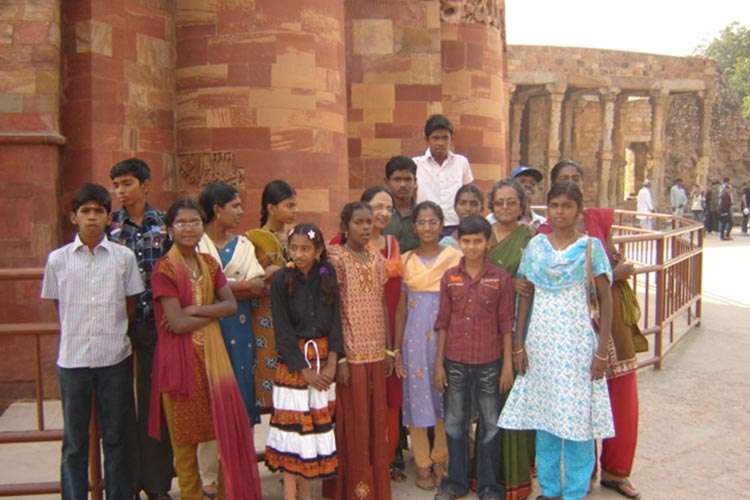 Our visit to Delhi was fortunate. This was the first time I was travelling so far. I had not been farther than 24 kms from my village till then. Delhi looked new to us. People were engaged in work, moving around briskly form early in the morning. People here looked different to us.
Our visit to Delhi was fortunate. This was the first time I was travelling so far. I had not been farther than 24 kms from my village till then. Delhi looked new to us. People were engaged in work, moving around briskly form early in the morning. People here looked different to us.
The places we went to in Delhi were all those that we study about. We went to India Gate, Taj Mahal (in Agra), Dolls Museum, National Museum, Parliament, Parliament museum, Qutab Minar, Purana Qila, Rashtrapati Bhavan, Gandhi Museum, and Jantar Mantar. Here, wherever you go, you see trees, playgrounds and flowering plants. The city was more beautiful than we had expected.
Indeed, it was amazing that we had come to Delhi from a tiny village in Tirunelveli District in Tamil Nadu. We had never even travelled by train. We experienced a lot in the tour. The metro Rail, the Hop-on-Hop-off bus, underground bazaar – all these were new to us. Even our teachers and parents have never been to Delhi. Our parents now talk about our tour with pride.
We will study well and work in Delhi in future. The places I liked best were Taj Mahal, Lotus Temple and the Red Fort. We are very fortunate and would like to thank all who helped us come.
A Rare Opportunity
T Sivasubramanian
I always wanted to visit places I have never been to before. I got a rare opportunity through YOKE (Youth of Kodaganallur Endeavour) to go to Delhi.
On November 5, we offered prayers in the local temple and left by auto-rickshaw for Tirunelveli railway station. Our parents and relatives had all come to the station to see us off. We reached Madurai and boarded another train. I found my berth and went to sleep. I got up at 6 am and sat by the window. There was a good breeze and I enjoyed the passing scenery as I looked out. On the seat next to mine, there was a person named Karthik. He was going to Delhi on work. I made friends with Karthik anna and spent all my time with him. When we reached Delhi, I felt sad to part with him.
We were welcomed at Nizamuddin station with a bouquet of flowers given to us by children. The next day, we first went to a temple. The idols were all made in marble and looked very nice. Then we went to Bal Bhavan and the Dolls Museum. We saw the costumes and dolls of many countries. In the evening there was a big party for us and we got to eat a very nice cake.
The next day we first went to a gurudwara. We had to cover our heads and go in. Later we went shopping to Sarojini Nagar market. There were thousands of people there and everything was quite cheap. I had never seen a market like this – it was my first experience of such a big market.


